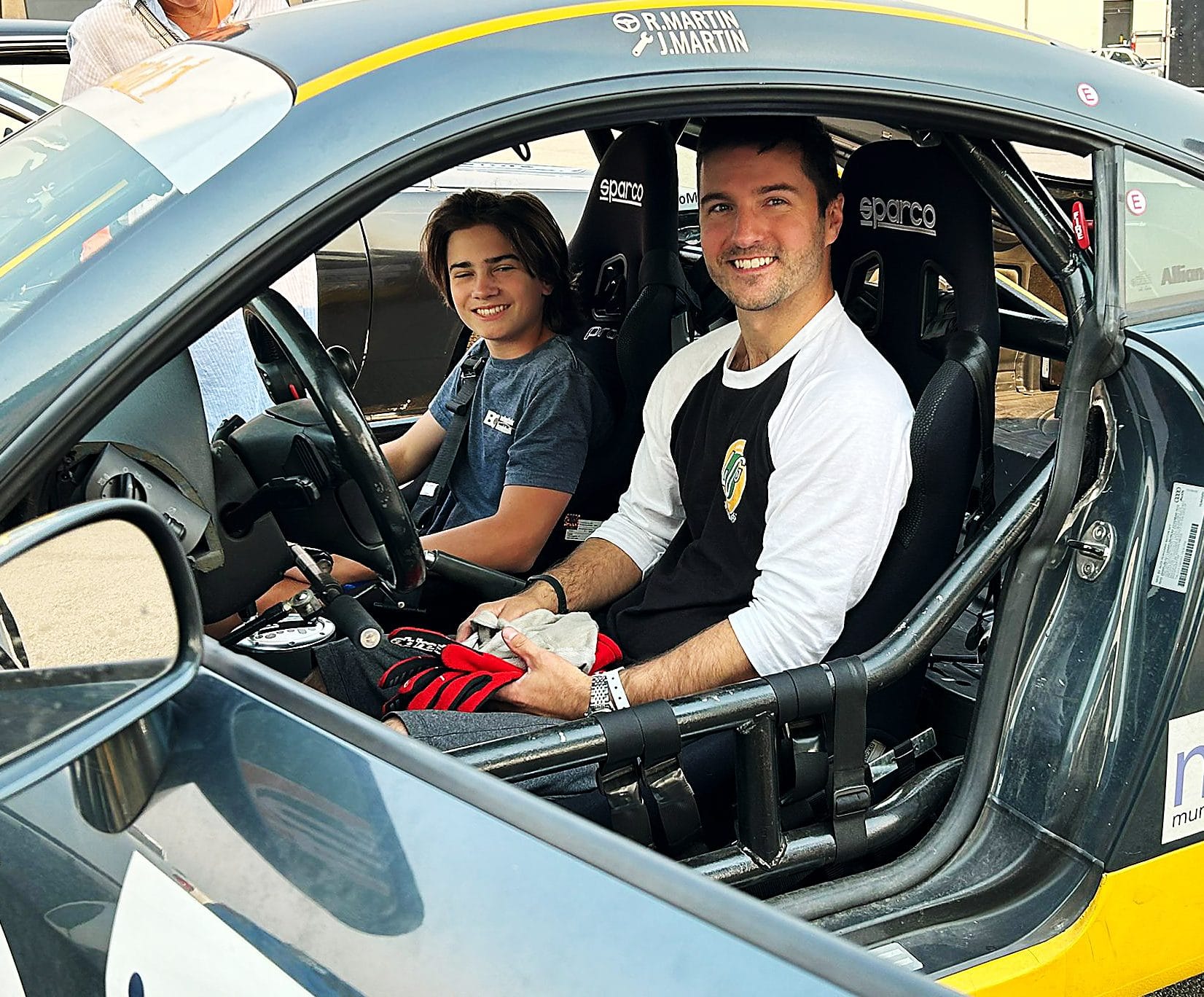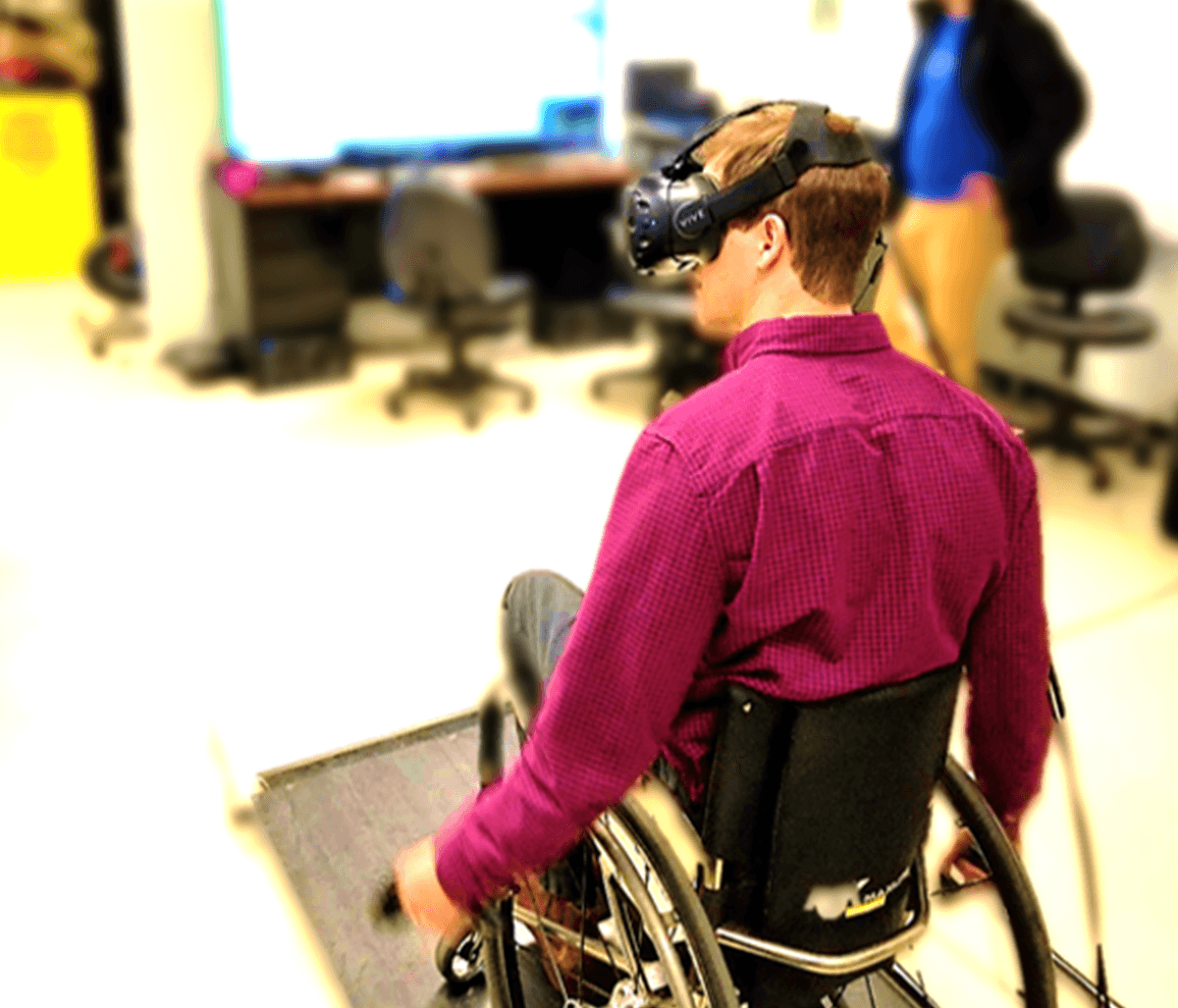
A photo of SCI BC peer Riley Martin’s late grandfather hangs in his kitchen. It’s black and white, and tiny specks of dust and sunspots have appeared on the film over time causing a grainy effect to cover the image. In it, Martin’s grandpa, Bill Martin, is behind the wheel of a 1950s race car with no bells or whistles, no roll cage, no flashy logos. Only his helmet-covered head and torso are visible as Bill is captured in the photo racing on a track somewhere in the Lower Mainland and rainwater sprays out behind his wheels (he is racing in the Lower Mainland, after all).
As The Spin talks with Martin; he holds up the photo and explains that his passion for racing is generational. “[My grandpa] built a race car with his friends and did some circuit racing in the 50s and then kind of passed that down to my Dad, who became a race mechanic during his undergrad in Vancouver in the 80s,” he says. Now, Martin continues the tradition of race car enthusiasm as a competitive driver at Area 27 Motorsports Park in Oliver, BC.
Area 27 is a training facility and racing circuit with a 4.83 kilometer course featuring 16 unique turns and 109-metre elevation. “When Area 27 came to Oliver, we got a membership before it was even built,” Martin says. “When it was open we started lapping and then just last year, we started actually racing.”

As someone with an SCI, the first step in pursuing racing was to connect with the Area 27 team and explore car options. “I don’t want to say I’m surprised, because I never really expected anyone to be against me competing or anything, but it’s been great to see the support. It’s been extremely positive for me… and really cool how much of a non-issue it was for the race track and the administration,” says Martin. The facilities at the track are all accessible and include a clubhouse with level entrances, accessible washrooms, and spectating locations for people of all abilities.
For Bill Drossos, President of Area 27 there weren’t any concerns regarding Martin’s driving ability, but some measures were implemented for increased safety. “What we have done from a safety aspect is improve the response time around the circuit in case of an incident like a vehicle fire. In Motorsports there can be challenging situations when extracting a driver from a damaged vehicle. At Area 27 we want to make the racing as safe as possible,” Drossos says.
This means that extra considerations were taken when building and equipping Martin’s car. For example, if a fire occurs while driving, he can pull a cord from inside the cockpit that starts a fire extinguisher in the engine and in the interior of the car. A tube is within reaching distance that can be controlled to direct the flow of extinguisher exhaust towards him. When purchasing the car, Martin and his Dad knew that hand controls were necessary, and that the transmission needed to be automatic – as Martin’s T3 SCI doesn’t allow him to switch between gears manually with a foot clutch. They ultimately decided on a 2004 Audi TT with a 3.2L VR6 Engine and all-wheel drive. “It took about 8 months altogether between sourcing the parts and getting certain things installed because we had to buy the car and then rip out all of the interior to make it really light,” Martin says, adding, “it was a really good experience with Dad, and I know that he absolutely loves to have this project with me.”

When it came to learning how to drive the car at speeds reaching up to 190 kilometers per hour and managing the resulting extreme g-force levels, Martin recounts three steps in the process. “The first is just learning how to drive the car fast and then two [is] learning how to drive the car fast against other people trying to do the same thing.” These steps were accomplished through a three-day driving academy at Area 27 with professional racing instructors guiding him and the other attendees through a series of practice sessions and tests.
Once successful, the third step is learning how to relay information about the car back to your team while racing. In Martin’s case, this means his Dad. “It’s incredibly exciting, there’s nothing else like it,” he says. “You start racing at the back of the pack so you’re learning how to race against other people trying to go as fast as I am … and that’s where communication comes into play. I have to let my Dad know what’s going right or wrong so he can keep improving [the car].” After successfully finishing five races, Martin moved into the middle of the group and continues progressing towards the front based on race results.
“I don’t feel disadvantaged out on the road because of the spinal cord injury,” he says. Martin’s T3 level injury means that he has no core or leg function, but has retained full hand function that he uses for driving. “Sometimes my hands get super tired because I use them to twist the throttle and push for the brake. I’m constantly twisting as hard as I can, and by the end of the race my arm is just dead and cramping. But, I mean, it’s also hard work for others with their feet and legs running the manual transmissions. I don’t think it’s a disadvantage necessarily, but it’s definitely a different aspect for me,” he says.

Martin’s racing techniques may be different, but he’s not the first to implement them. “It’s true that it’s not common to see someone with a spinal cord injury in a race car,” explains Drossos. “Having said that, there have been some extremely amazing exceptions, including Alex Zanardi and Robert Wickens. Both drivers lost the use of their legs due to horrible accidents in Indycar. Both drivers recovered and came back to race again and … [exhibited] incredible determination, and perseverance, in the face of enormous adversity. At Area 27, Martin is the guy who exemplifies those same attributes.”
This sense of determination propelled Martin to compete in his first GT 27 Continental Cup at Area 27 Motorsports Park in 2022. The Cup series consisted of 10 races between a pool of competitive novice racers with a variety of cars. Last year, he placed 16th out of 30 overall and received the Rookie of the Year award. This year, “I’m trying to improve more and more and get into the top ten and then hopefully as close to the podium as we can get,” he says. In addition, Martin and his Dad plan to continue to elevate the family tradition of racing by making incremental changes to the car. “Dad and I still have a bunch of, like, really small things that we can continually improve on the car. And we’ll do those together.
Most recently, the Martin family’s passion for racing has extended to another SCI BC peer. Lucas Van Herk, who lives in Chilliwack, BC showed interest in the sport and was invited out to Area 27 by Martin to take a ride in the car. “He absolutely loved it out there and I don’t doubt he caught a bit of a racing bug,” Martin says. Catching the ‘bug’ for the sport is crucial, but Martin recognizes that it’s only one piece of the puzzle when it comes to making the transition from fan to participant. Another significant factor for people considering getting into racing, especially for those with an SCI, is cost.

Racing is one of the most expensive sports to pursue and personally financing a track’s membership as well as purchasing, upgrading, and maintaining a car is nearly impossible. For Martin, the ability to race comes back to the sense of legacy and community that got him into racing in the first place. “For Dad and me to save a lot on shop labor, he did the labor himself, and we were able to pick up a few sponsors in the meantime,” he says. “Our main sponsor is KSW Lawyers. They represented me after my motor vehicle accident and my injury so there’s the connection there,” Martin explains. “I’ve also got my realtor as a sponsor. His Dad sponsored a car back in the Netherlands where he’s from, so that’s also a personal connection for him, to continue to do that here. And Alliance Mobility Solutions gave us our hand controls and some funding because I’ve had them do stuff on my cars in the past… it’s a collective effort and it absolutely makes a difference on our ability to be able to do this project.”
Overall, for Martin, the price tag of racing is worth the reward. “I’ve been watching races for like the past 15 years. I love it and its always just kind of been something that’s been passed down,” he says. Through racing, he hopes to continue sharing this enthusiasm with others. “I know a lot of spinal cord injuries come from adrenaline related accidents, so for others to see that there is a way to get back to experiencing those things or something you enjoy… I know it’s something I definitely would’ve liked to have seen for sure.” Undoubtedly, this commitment to bolstering the sport and broadening its accessibility is something that Martin’s late grandfather would have been proud to race towards.
If you want to learn more about Martin’s racing pursuit, you can visit the Martin Racing team website at www.rileym.ca or catch one of his races at Area 27 Motorsports Park in Oliver, BC. You can also learn more about Area 27 at www.area27.ca.
This article originally appeared in the Fall 2023 issue of The Spin. Read more stories from this issue, including:
- Virtual reality research
- Aging with SCI
- Accessibility in BC
And more!




